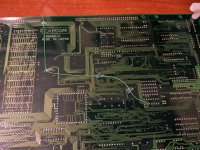Tailsnic Retroworks
Grand Master
Hi. Today I'm going to investigate a possible solution to an issue I have detected, and I want to share my thoughts.
I have a Daimakaimura board with broken C board (B-01 chip), so I have tested the Openkey with a B-21 programmable chip.
I have detected a small issue. With this game, there is a little probability (on first boot) it'll show me black screen with music on background.
This exact situation occurs when you power on the game without a C board or with a C board without codes. I have been thinking and this is because there is the possibility of, depending on the power supply, the game tries to boot just before the injection ends (or even boots in the middle of the injection causing bad graphics, I have experienced also that).
When this occurs, I just simply reboot the game (the codes can be inside the B-21 chip many minutes), and It boots perfectly.
So, my suggestion is to use one available pin on the ATtiny404 to throw a reset pulse on pin 103 of the B-21. I have not tested it yet, but this would do a general reset of the game just like CPS2 openkey does, and guarantee a 100% boot up success.
I have a Daimakaimura board with broken C board (B-01 chip), so I have tested the Openkey with a B-21 programmable chip.
I have detected a small issue. With this game, there is a little probability (on first boot) it'll show me black screen with music on background.
This exact situation occurs when you power on the game without a C board or with a C board without codes. I have been thinking and this is because there is the possibility of, depending on the power supply, the game tries to boot just before the injection ends (or even boots in the middle of the injection causing bad graphics, I have experienced also that).
When this occurs, I just simply reboot the game (the codes can be inside the B-21 chip many minutes), and It boots perfectly.
So, my suggestion is to use one available pin on the ATtiny404 to throw a reset pulse on pin 103 of the B-21. I have not tested it yet, but this would do a general reset of the game just like CPS2 openkey does, and guarantee a 100% boot up success.




